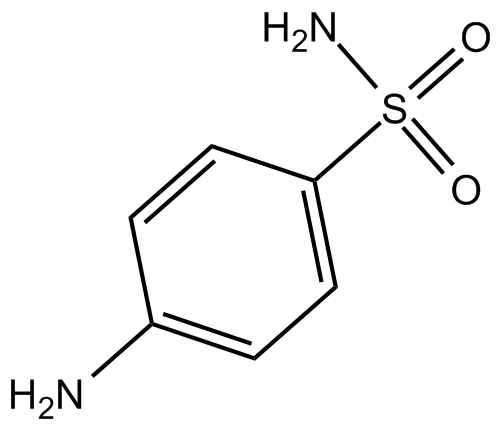Sulfanilamide (Synonyms: 4-Aminobenzenesulfonamide, p-Aminobenzenesulfonamide, NSC 7618, Ro 1-3354) |
| Catalog No.GC15626 |
L'ulfanilamide (Sulfanilamide) est un antibiotique sulfamide puissant et actif par voie orale et peut être un intermédiaire majeur de la biodégradation du sulfaméthoxazole.
Products are for research use only. Not for human use. We do not sell to patients.

Cas No.: 63-74-1
Sample solution is provided at 25 µL, 10mM.
Sulfanilamide is a competitive inhibitor for bacterial enzyme dihydropteroate synthetase with IC50 of 320 μM.Target: dihydropteroate synthetase; AntibacterialSulfanilamide containing the sulfonamide functional group displays inhibitory activity for dihydropteroate synthetase partially purified from Escherichia coli which normally uses para-aminobenzoic acid (PABA) for synthesizing the necessary folic acid acting as a coenzyme in the synthesis of purine, pyrimidine and other amino acids, exhibiting an IC 50 of 320 μM for dihydropteroate synthetasea and Km of 2.5 uM for PABA [1]. Sulfanilamide shows IC50 of 286.8 μg/mL for recombinant S. cerevisiae strains with wild-type FOL1 genes, but the single mutation 55Trp to 55Ala or 57Pro to 57Ser within the putative active site of the fungal DHPS confers resistance to Sulfanilamide with IC50 of >800 μg/mL [2]. Administration of Sulfanilamide with the dosage of 100 mg/kg/day is effective in the prevention of P. carinii infection in the immunosuppressed rat model. When the dosage of sulfaguanidine and Sulfanilamide reduced to 10 mg/kg/day, breakthrough P. carinii infection occurs in the rats [3].
References:
[1]. McCullough, J.L. and T.H. Maren, Inhibition of dihydropteroate synthetase from Escherichia coli by sulfones and sulfonamides. Antimicrob Agents Chemother, 1973. 3(6): p. 665-9.
[2]. Meneau, I., et al., Pneumocystis jiroveci dihydropteroate synthase polymorphisms confer resistance to sulfadoxine and sulfanilamide in Saccharomyces cerevisiae. Antimicrob Agents Chemother, 2004. 48(7): p. 2610-6.
[3]. Hughes, W.T. and J. Killmar, Monodrug efficacies of sulfonamides in prophylaxis for Pneumocystis carinii pneumonia. Antimicrob Agents Chemother, 1996. 40(4): p. 962-5.
Average Rating: 5 (Based on Reviews and 23 reference(s) in Google Scholar.)
GLPBIO products are for RESEARCH USE ONLY. Please make sure your review or question is research based.
Required fields are marked with *




















